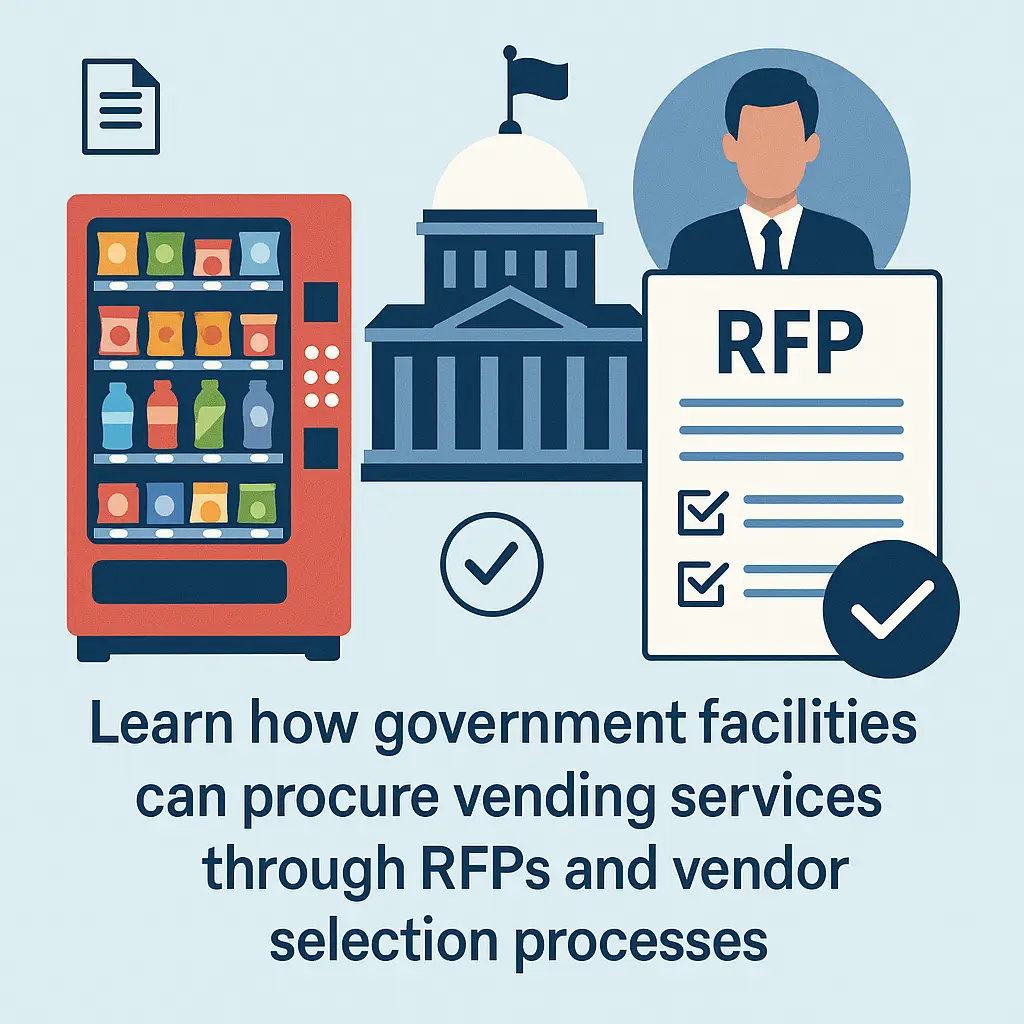Procurement of Vending Services for Government Entities
Learn how government facilities can procure vending services through RFPs and vendor selection processes.
Back to Vending for Public Buildings ResourcesLearn how government facilities can procure vending services through RFPs and vendor selection processes.
Back to Vending for Public Buildings ResourcesStart with a clear RFP outlining scope, compliance needs, and service expectations. Evaluate bids objectively based on cost, quality, and operational standards.
![]() Understand government RFP requirements for vending installations
Understand government RFP requirements for vending installations
![]() Identify key evaluation factors for selecting reliable vending solutions
Identify key evaluation factors for selecting reliable vending solutions
![]() Ensure compliance with procurement and accessibility regulations
Ensure compliance with procurement and accessibility regulations

Government entities often follow structured procurement processes when introducing vending services into their buildings. This typically involves issuing a Request for Proposal (RFP), evaluating multiple responses, and ensuring compliance with local, state, or federal regulations. A clear understanding of these steps helps avoid delays and ensures the chosen solution aligns with operational goals.
Facilities should begin by outlining key objectives, including product variety, payment options, accessibility standards, and maintenance expectations. Early planning makes it easier to craft detailed RFPs that attract qualified respondents and reduce ambiguity during evaluation.
Strong RFPs provide a transparent framework for interested parties. They should include service expectations, placement guidelines, equipment specifications, and compliance requirements. Government buildings often require ADA-compliant equipment and may have healthy vending standards to follow. By articulating these factors upfront, agencies can streamline responses and select solutions that meet regulatory and operational needs.
Including clear evaluation criteria also reduces the risk of misunderstandings later. For example, emphasizing technology features like cashless payment systems or smart inventory monitoring can help facilities modernize their vending offerings while keeping operations efficient. For more guidance on innovative vending technologies, explore how smart vending options are transforming public spaces.
Once proposals are received, structured evaluation is critical. A review committee should assess responses based on cost, service quality, product selection, technology capabilities, and compliance with regulations. Site visits or equipment demonstrations can provide additional assurance that proposed solutions meet expectations. It's also useful to examine how vendors plan to maintain uptime and handle service calls.
Government procurement often involves strict recordkeeping and transparency requirements. Documenting evaluation steps ensures accountability and helps defend decisions if questioned. For insights into managing ongoing operations after selection, check out best practices for facilities management.
Cost is an important factor, but it's not the only one. Long-term reliability, compliance, and accessibility should carry significant weight in the decision. Choosing the lowest-cost option without considering service standards can lead to recurring issues down the road. Strategic procurement focuses on long-term value rather than short-term savings.
For a broader perspective on planning and setup considerations, you can also review this detailed guide to planning vending installations.
If you're exploring vending options for your business, Vending Exchange can help simplify the process. Delivery, Installation and Equipment is provided at no cost to you - vendors provide the machines, keep them stocked, and handle all servicing. Whether you need a provider or full-service management, just fill out the form on this page to get started.
The process usually begins with drafting a detailed RFP that defines goals, requirements, and evaluation criteria.
RFPs provide a transparent, structured way to solicit and compare multiple solutions while ensuring compliance.
They should follow local, state, and federal procurement rules, include ADA requirements, and document each step.
Key details like service expectations, equipment specs, healthy vending guidelines, placement plans, and evaluation methods.
Using clear scoring rubrics that consider cost, service quality, compliance, and technology helps ensure objective decisions.
ADA compliance is critical; machines must be usable by all visitors, including those with disabilities.
Clear timelines, standardized evaluation criteria, and involving multiple departments can make the process more efficient.
Rushing RFP creation, unclear evaluation criteria, and overlooking long-term service reliability are frequent issues.
Selecting solutions based on service reliability, not just cost, and setting clear maintenance expectations helps ensure success.
Yes. Demonstrations provide insight into equipment performance, payment systems, and overall service quality before selection.